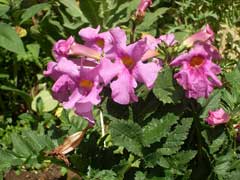
Hardy Gloxinia
Latin Name: Incarvillea delavayi
USDA Hardiness: 7-9
Native Range: TEMPERATE ASIA: China (Sichuan Sheng, Yunnan Sheng (northwest))
Edibility Rating: 1 / 5
Medicinal Rating: 0 / 5
Region:
Family:
Plant Type:
Medicinal Uses
Edible Uses
Edible Parts: Leaves Shoots | Edible Uses: Leaves and young shoots - cooked. A famine food, it is only used when all else fails[179]. Some caution is advised, see the notes above on toxicity.
Cultivation
Landscape Uses:Alpine garden, Border, Container, Rock garden, Specimen. Easily grown in a deep sandy but rich soil in full sun[187, 200]. Plants grow better if given some shade around midday[200]. Prefers a well-drained calcareous or neutral soil[214] and is drought tolerant when established[190]. Another report says that it dislikes dry summer soils[200]. Dislikes winter wet[200]. Prefers a sheltered position[214]. Plants are hardy to about -15°c, tolerating even lower temperatures if the roots are well mulched, preferably with dry bracken[1, 187, 200]. The crown of the plant requires protection from slugs in the winter[187]. A very ornamental plant, it usually takes about 3 - 4 years to come into flower from seed[214]. This species is often confused in cultivation with I. mairei[214]. Plants are intolerant of root disturbance, it is best to place them in their permanent positions whilst small[200]. The plants will often sulk for several years if they are divided[214]. Special Features: Attractive foliage.
Known Hazards
One report suggests that the plant might be slightly toxic[179].
Habitats
Grassy places and scrub around 2000 metres[187]. Pastures and open grassland, 2400 - 3500 metres, but it is now uncommon in its native range[200].
